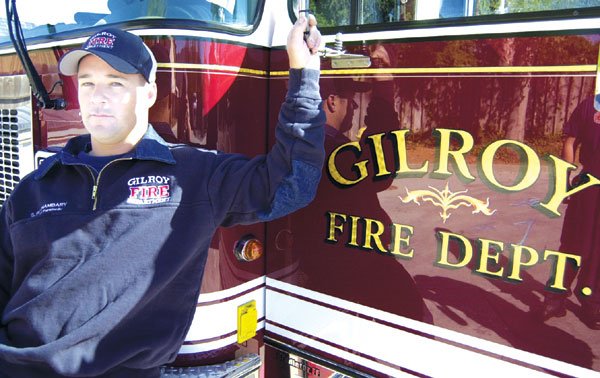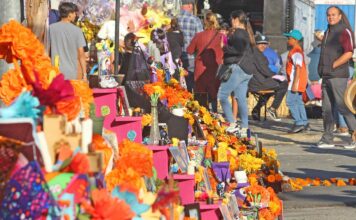Gilroy
– The wish list for the Gilroy Fire Department includes a number
of items, and union requests for improved benefits loom in the
background.
Fire Chief Hugh Holden and Division Chief David Bozzo recently
presented the city council with an update on the fire department’s
master plan, which outlines about 21 different needs for staffing,
equipment and other department programs over the next 15 years.
Gilroy – The wish list for the Gilroy Fire Department includes a number of items, and union requests for improved benefits loom in the background.
Fire Chief Hugh Holden and Division Chief David Bozzo recently presented the city council with an update on the fire department’s master plan, which outlines about 21 different needs for staffing, equipment and other department programs over the next 15 years.
While the requests for better benefits is a union contract issue, the items requested in the master plan update would be paid for by the city’s general fund.
One of the biggest requests is to build a new fire station in 2009 in the city’s southwest quadrant, near the Eagle Ridge community. Right now, calls from Eagle Ridge go to the Las Animas station on Wren Avenue, violating the department’s five-minute response rule, said Gilroy Firefighters Local 2805 negotiator Jim Buessing.
In addition to a new station, the department is hoping to build a training facility by 2018 that could be used regionally for fire departments in other South County cities, Holden said.
To help keep pace with Gilroy’s growth, the department wants to add two more firefighters to the newly constructed Sunrise station, which currently only has one fire captain and one firefighter/paramedic.
The area surrounding the Sunrise station is more than 80 percent developed, qualifying it for a full staff of four firefighters, Holden said. The area met the required 50-percent threshold for volume of calls in the late 1990s, said City Administrator Jay Baksa.
The Sunrise station also needs a fire engine, Buessing said. Currently the station uses a vehicle known as the STAR car, which transports accident victims to the hospital under certain conditions but has no firefighting capabilities.
A main reason for increasing staffing is to ensure the safety of firefighters, Buessing said.
“The more people you have for the job, the safer it is for our members,” he said.
Buessing said the union also hopes to renovate the two older stations to bring them up to modern standards. The Chestnut station, constructed in 1971, and the Las Animas station, constructed in 1977, each have a fire engine and four firefighters. The Chestnut station also houses the department’s administrative staff.
Both stations have two bathrooms, and the Las Animas station only has one shower. The brand new Sunrise station has four showers.
The union is still trying to improve working conditions, wages and benefits for Gilroy’s firefighters, Buessing said.
“Those are the three areas we’re mostly concerned with,” he said. “What we strive for is parity. … The issue is parity to what the police officers have and parity compared to the rest of the (Santa Clara) County, as well as statewide.”
The union’s current contract is scheduled to expire at the end of this year. The union has to wait for CalPERS to release some information before it can start talking about detailed numbers, Buessing said. That could happen as late as November.
CalPERS stands for the California Public Employees’ Retirement System, and it provides retirement and health benefits for more than 1.4 million public employees, retirees and their families and more than 2,500 employers.
One of the main issues of union negotiations – which are ongoing – is a retirement plan called 3 percent at 50. Currently, Gilroy Police Department retirees get paid 3 percent of their last year’s salary for every year they worked at the department, and they can retire at age 50.
For example, if a police officer retires after working for the department for 30 years, the officer will receive an annual retirement check for 90 percent of his or her closing salary, which is the maximum that can be paid.
Under Gilroy firefighters’ current contract, firefighters are given 2 percent of their last year’s salary, multiplied by how many years they worked at the department, for their retirement pay. The firefighters union is trying to increase that to 3 percent to match Gilroy’s police department. Buessing said 3-at-50 or 3-at-55 has been a statewide standard for firefighters for a few years.
Because of increased specialty training, firefighters are entering the work force at a later age – usually older than 25, Buessing said – and the 2-percent plan doesn’t provide as much financial stability for retirees as does the 3 percent plan.
Additionally, he said, life expectancy of firefighters after they’ve retired is only about 10 to 15 years because of the physical demands.
“You know you’re not gonna live forever after you retire if you’re a firefighter,” Buessing said. “So 3-at-50 or 3-at-55 makes it more financially feasible once you do decide to retire.”
In 1999, the issue of adding an additional fourth firefighter to Gilroy engine companies sparked a two-year debate between Local 2805 and the city that eventually required the help of a private arbitrator to settle. Local 2805 was finally given approval for the extra firefighter. Buessing said he doesn’t want negotiations to reach that point again.
On a lighter note, the department soon will be wearing a revised version of their uniforms. A prototype of the updated uniform was presented to council last week by fire engineer Colette Harmon and firefighters/paramedics Shawn Peyhgambary and Scott MacDonald.
Instead of a gold badge on the front of the firefighters uniforms – which made it easy to mistake them for police officers – the new uniforms have a Gilroy Fire Department logo patch on each sleeve. Firefighters also will receive quarter-zip pullovers with the same logo across the front and shorts to wear during the Garlic Festival and other hot summer days, said Division Chief Phil King.
The process of redesigning the uniforms took about a year, King said. A uniform committee created the final design, with input from department members and a few different design companies.
Firefighters will start wearing the new gear officially when the proposal is adopted, which King said he hopes will happen soon.
So, why the change?
“It will help make ourselves more identifiable to the public,” King said. “We’ll look more like a fire department, and we’ll look more professional.”














